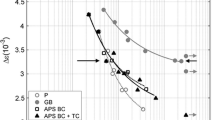Abstract
The effects of corrosive wet conditions on the progress of fatigue were studied by means of wet-dry two-stage tests of same stress level. Some results from the two-state tests—invariability, hesitation, etc., during the progress of fatique fracture—are discussed on the basis of results of measurements made on corrosionfatigue cracks and anlaysis by the equations of crack propagation.
Several new methods for measurement of corrosionfatigue cracks were developed for this purpose.
Similar content being viewed by others
References
McAdam, D. J., Jr. andGeil, G. W., “Influence of Cyclic Stress on Corrosion Pitting of Steels in Fresh Water, and Influence of Stress Corrosion on Fatigue Limit,”Jnl. Res. Natl. Bre. Sta.,24,685 (July1940).
McAdam, D. J., Jr. andGeil, G. W., “Pitting and its Effect on the Fatigue Limit of Steels Corroded under Various Conditions,”Proc. ASTM,41,696 (1941).
Gough, H. J., andSopwith, D. G., “The Behaviour of a Single Crystal of Aluminum under Alternating Torsional Stresses while Immersed in a Slow Stream of Tap Water,”Proc. Roy. Soc., A,135 (827),392 (March1932).
Gough, H. J., andSopwith, D. G., “Corrosion-Fatigue Characteristics of an Aluminum Specimen Consisting of Two Crystals,”Jnl. Inst. Metals,52 (2),57 (Sept.1933).
Gough, H. J., “Corrosion-Fatigue of Metals,”,49 (2),17 (1932).
Brumfield, R. C., “A Sulfur Print Method for the Study of Crack Growth in the Corrosion-Fatigue of Metals,”Proc. ASTM, 45,544 (1945).
Endo, K., Nagai, K., andArizaki, K., “On the Crack Length and the Low Temperature Brittleness of a Carbon Steel Subjected to Corrosion Fatigue,”Trans. Japan Soc. Mech. Engrs.,27 (179),1100 (July1961).
Hara, S., Hoshino, J., andArai, J., “Bending Fatigue Tests on Large Specimens under Sea Water Corrosion,”Trans. Zosenkyokai (Trans. Japan Soc. Ship-builder),107, 121 (1960).
Matsuyama, T. andHaruyama, T., “A Study on Corrosion Fatigue (The First Report),”Preprint 36th Ordinary Meeting of Japan Soc. Mech. Engrs., 2, 21 (April1959).
Okamoto, S., and Kitagawa, H., “Some Behaviors of Structural Steel Subjected to Corrosion Fatigue (The 2nd Report),” Proc. 8th Japan Natl. Congr. Appl. Mech., 1958, 187 (March 1959).
Evans, U. R., andSimnad, M. T., “The Mechanism of Corrosion Fatigue of Mild Steel,”Proc. Roy. Soc., A, 188, 372 (Feb.1947).
Simnad, M. T., andEvans, U. R., “The Mechanism of Corrosion Fatigue of Steels in Acid Solution,”Jnl. Iron Steel Inst., 156, Pt. 4, 531 (Aug.1947).
Author information
Authors and Affiliations
Rights and permissions
About this article
Cite this article
Kitagawa, H. Invariability, hesitation or restoration of damage in wet-dry fatigue process. Experimental Mechanics 7, 28–35 (1967). https://doi.org/10.1007/BF02326837
Issue Date:
DOI: https://doi.org/10.1007/BF02326837




